diff options
| author | Daniel Baumann <daniel.baumann@progress-linux.org> | 2021-02-07 11:49:00 +0000 |
|---|---|---|
| committer | Daniel Baumann <daniel.baumann@progress-linux.org> | 2021-02-07 12:42:05 +0000 |
| commit | 2e85f9325a797977eea9dfea0a925775ddd211d9 (patch) | |
| tree | 452c7f30d62fca5755f659b99e4e53c7b03afc21 /docs/netdata-cloud | |
| parent | Releasing debian version 1.19.0-4. (diff) | |
| download | netdata-2e85f9325a797977eea9dfea0a925775ddd211d9.tar.xz netdata-2e85f9325a797977eea9dfea0a925775ddd211d9.zip | |
Merging upstream version 1.29.0.
Signed-off-by: Daniel Baumann <daniel.baumann@progress-linux.org>
Diffstat (limited to 'docs/netdata-cloud')
| -rw-r--r-- | docs/netdata-cloud/README.md | 46 | ||||
| -rw-r--r-- | docs/netdata-cloud/nodes-view.md | 208 | ||||
| -rw-r--r-- | docs/netdata-cloud/signing-in.md | 157 |
3 files changed, 0 insertions, 411 deletions
diff --git a/docs/netdata-cloud/README.md b/docs/netdata-cloud/README.md deleted file mode 100644 index 9ed6330b..00000000 --- a/docs/netdata-cloud/README.md +++ /dev/null @@ -1,46 +0,0 @@ -# Netdata Cloud - -Netdata Cloud is core to our ongoing mission to provide real-time, distributed health monitoring and performance troubleshooting. It's the foundation of an ecosystem of tools that will help you build more extraordinary infrastructures. - -Netdata Cloud is also the next iteration of our global Netdata registry. For technical information about how our registries work, what information they store, and how your web browser "talks" to both, visit our [registry documentation](../../registry). - -Learn more about the future of Netdata Cloud on our [announcement post](https://blog.netdata.cloud/posts/netdata-cloud-announcement/). - -## Registering for or signing in to Netdata Cloud - -**If you're ready to register for a new Netdata Cloud account, or sign in to your existing Netdata Cloud account, visit our [signing in guide](signing-in.md) for details.** - -!!! attention "Private registries and Netdata Cloud" - If you're running a private registry and are interested in trying out Netdata Cloud as a replacement for your private registry, read [our notice](signing-in.md#private-registries-and-netdata-cloud) about transitioning from a private registry to our Netdata Cloud registry. - -## Netdata Cloud features - -Netdata Cloud currently enables two features: the **My nodes** in the top-left corner of the Netdata dashboard, and the [**Nodes View**](nodes-view.md). - -We have an aggressive roadmap of new features, such as Workspaces for different parts of your infrastructure, Rooms to collaborate with colleagues, and the ability to receive alarms from any number of distributed Netdata agents in a single place. Read more about our proposed features [here](https://blog.netdata.cloud/posts/netdata-cloud-announcement/#what-features-will-netdata-cloud-offer). - -### Planned enterprise features (paid) - -Large enterprises have unique real-time monitoring needs. They have thousands of servers and applications running concurrently, and are willing to pay for the complex features that help them make smarter, faster decisions about their infrastructure. We expect to create a paid tier of Netdata Cloud with a recurring, per-user pricing model that will unlock enterprise-focused features. - -A few of these planned features include: - -- Long-term storage of Netdata UI snapshots -- Active Directory integration for single sign-on -- Private service status pages -- Extended retention of alarms timelines -- Incident response toolkits -- Additional enterprise plugins and integrations -- Extended retention of chat messages - -Again, we expect that the vast majority of Netdata's users won't need these features. Creating these two tiers will help us further fund the company's efforts to deploy Netdata's open-source agent on a massive scale and entirely for free. - -## Running Netdata without Netdata Cloud - -Netdata Cloud is entirely optional. The application will never force you to create a Netdata Cloud account or associate nodes with the public registries. But, if you choose not to use Netdata Cloud, you will be missing out on the [Nodes View](nodes-view.md) and other upcoming features. - -## Running Netdata Cloud on-premises or as a hosted instance - -We plan on making both on-premises and hosted instances of Netdata Cloud available to enterprises. Until then, we are creating a list of people and businesses interested in either of these options. To add yourself or your organization to this list, email us at [info@netdata.cloud](mailto:info@netdata.cloud). - -[](<>) diff --git a/docs/netdata-cloud/nodes-view.md b/docs/netdata-cloud/nodes-view.md deleted file mode 100644 index 1e91639d..00000000 --- a/docs/netdata-cloud/nodes-view.md +++ /dev/null @@ -1,208 +0,0 @@ -# Using the Nodes View - -## Introduction - -As of v1.15.0 of Netdata, and in conjunction with our announcement post about the [future of Netdata](https://blog.netdata.cloud/posts/netdata-cloud-announcement/), we have enabled an entirely new way to view your infrastructure using the open-source Netdata agent in conjunction with Netdata Cloud: the **Nodes View**. - -This view, powered by Netdata Cloud, provides an aggregated view of the Netdata agents that you have associated with your Netdata Cloud account. The main benefit of Nodes View is seeing the health of your infrastructure from a single interface, especially if you have many systems running Netdata. With Nodes View, you can monitor the health status of your nodes via active alarms and view a subset of real-time performance metrics the agent is collecting every second. - -!!! attention "Nodes View is beta software!" - The Nodes View is currently in beta, so all typical warnings about beta software apply. You may come across bugs or inconsistencies. - -``` -The current version of Nodes uses the API available on each Netdata agent to check for new alarms and the machine's overall health/availability. In the future, we will offer both polling via the API and real-time streaming of health status/metrics. -``` - -## The Nodes View - -To access the Nodes View, you must first be signed in to Netdata Cloud. To register for an account, or sign in to an existing account, visit our [signing in guide](signing-in.md) for details. - -Once you're signed in to Netdata Cloud, clicking on any of the **Nodes Beta** buttons in the node's web dashboard will lead you to the Nodes View. Find one (`1`) in the dropdown menu in the upper-right corner, a second (`2`) in the top navigation bar, and a third (`3`) in the dropdown menu in the top-left corner of the Netdata dashboard. - -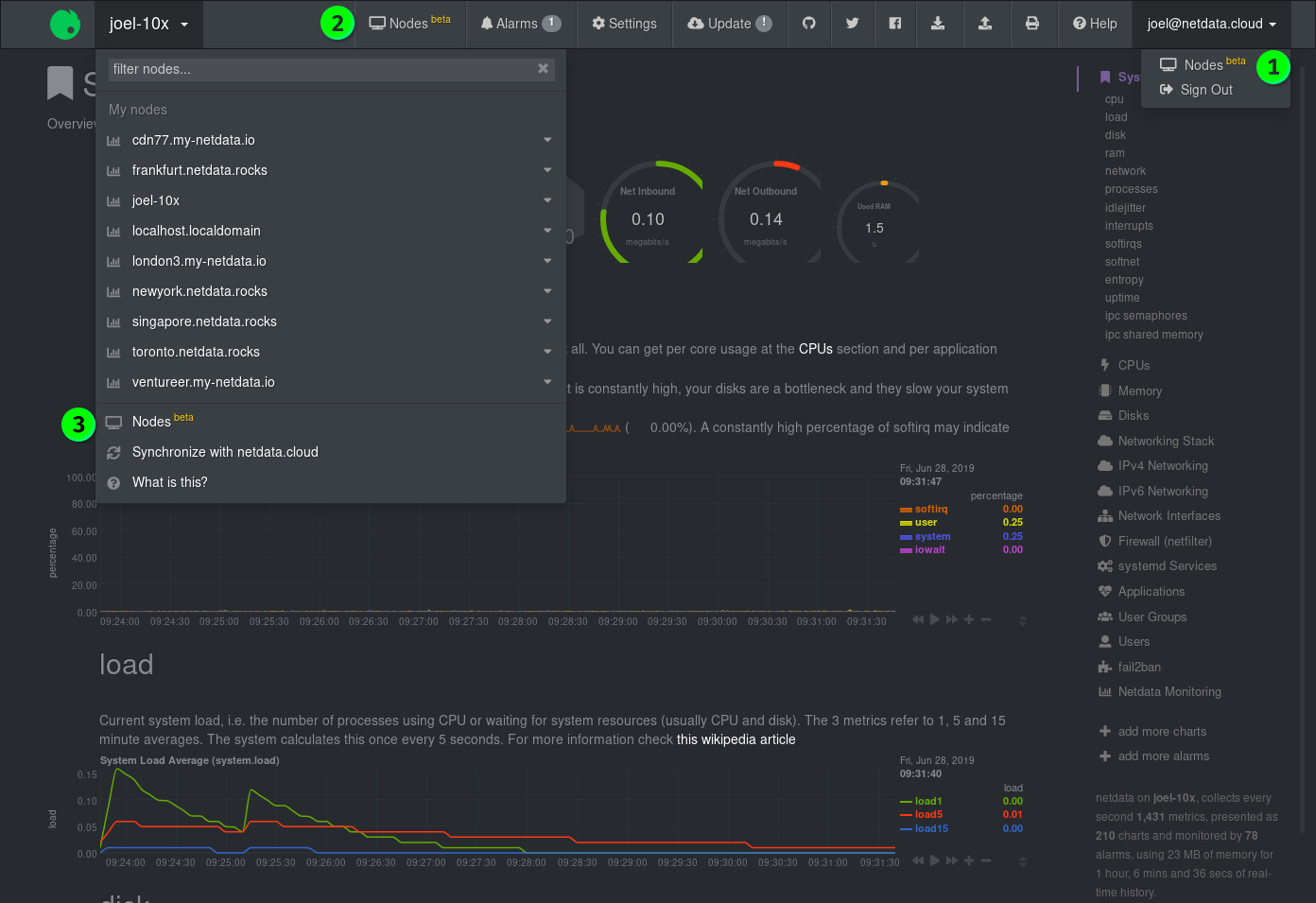 - -### Nodes - -The primary component of the Nodes View is a list of all the nodes with Netdata agents you have associated with your Netdata Cloud account via the Netdata Cloud registry. - -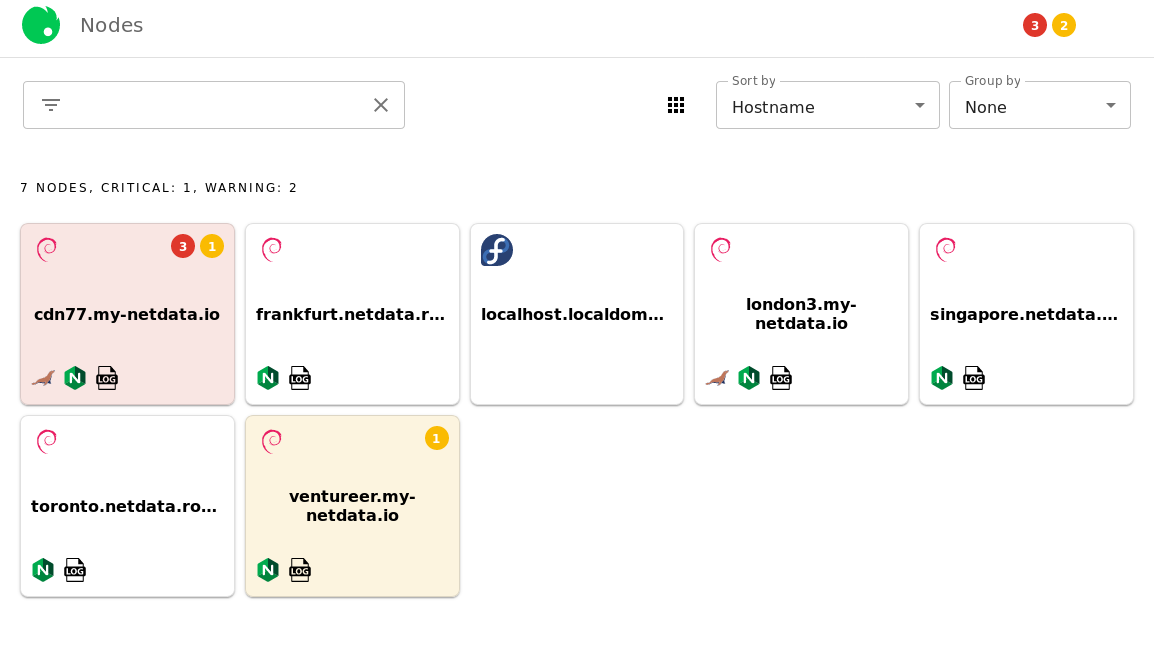 - -Depending on which [view mode](#view-modes) you're using, Nodes View will present you with information about that node, such as its hostname, operating system, warnings/critical alerts, and any [supported services](#Services-available-in-the-Nodes-View) that are running on that node. Here is an example of the **full** view mode: - -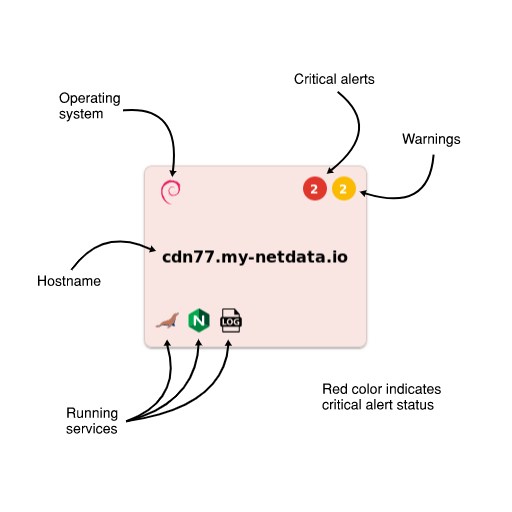 - -The background color of each Node entry is an indication of its health status: - -| Health status | Background color | -| ------------- | ------------------------------------------------------------------------------------------------- | -| **White** | Normal status, no alarms | -| **Yellow** | 1 or more active warnings | -| **Red** | 1 or more active critical alerts | -| **Grey** | Node is unreachable (server unreachable [due to network conditions], server down, or changed URL) | - -### Node overview - -When you click on any of the Nodes, an overview sidebar will appear on the right-hand side of the Nodes View. - -This overview contains the following: - -- An icon (`1`) representing the operating system installed on that machine -- The hostname (`2`) of the machine -- A link (`3`) to the URL at which the web dashboard is available -- Three tabs (`4`) for **System** metrics, **Services** metrics, and **Alarms** -- A number of selectors (`5`) to choose which metrics/alarms are shown in the overview - - **System** tab: _Overview_, _Disks_, and _Network_ selectors - - **Services** tab: _Databases_, _Web_, and _Messaging_ selectors - - **Alarms** tab: _Critical_ and _Warning_ selectors -- The visualizations and/or alarms (`6`) supported under the chosen tab and selector -- Any other available URLS (`7`) associated with that node under the **Node URLs** header. - -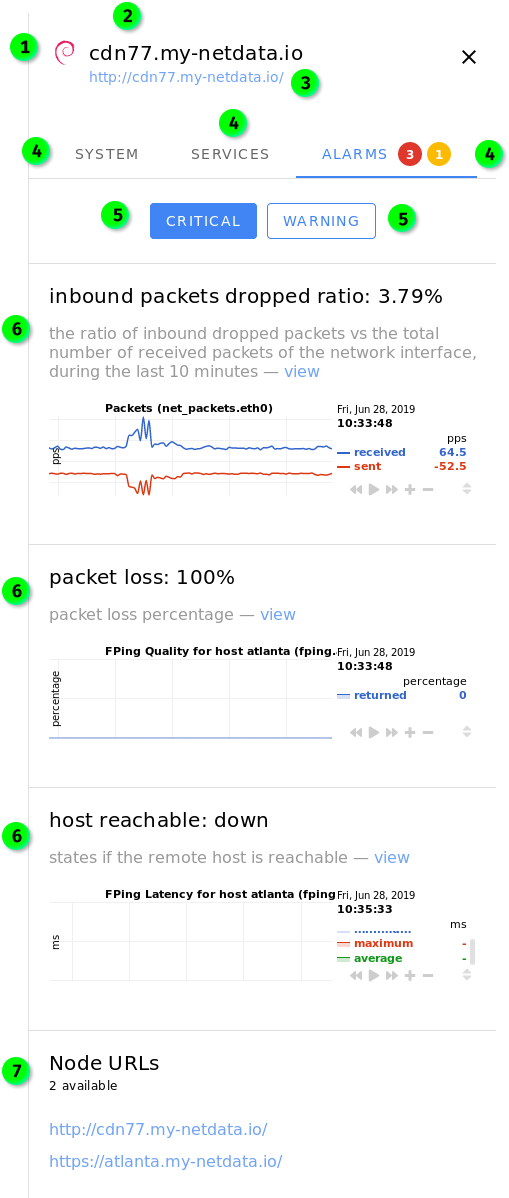 - -By default, clicking on a Node will display the sidebar with the **System** tab enabled. If there are warnings or alarms active for that Node, the **Alarms** tab will be displayed by default. - -**The visualizations in the overview sidebar are live!** As with all of Netdata's visualizations, you can scrub forward and backward in time, zoom, pause, and pinpoint anomalies down to the second. - -#### System tab - -The **System** tab has three sections: *Overview*, *Disks*, and *Network*. - -_Overview_ displays visualizations for `CPU`, `System Load Average` `Disk I/O`, `System RAM`, `System Swap`, `Physical Network Interfaces Aggregated Bandwidth`, and the URL of the node. - -_Disks_ displays visualizations for `Disk Utilization Time`, and `Disk Space Usage` for every available disk. - -_Network_ displays visualizations for `Bandwidth` for every available networking device. - -#### Services tab - -The **Services** tab will show visualizations for any [supported services](#Services-available-in-the-Nodes-View) that are running on that node. Three selectors are available: _Databases_, _Web_, and _Messaging_. If there are no services under any of these categories, the selector will not be clickable. - -#### Alarms tab - -The **Alarms** tab contains two selectors: _Critical_ and _Warning_. If there are no alarms under either of these categories, the selector will not be clickable. - -Both of these tabs will display alarms information when available, along with the relevant visualization with metrics from your Netdata agent. The `view` link redirects you to the web dashboard for the selected node and automatically shows the appropriate visualization and timeframe. - -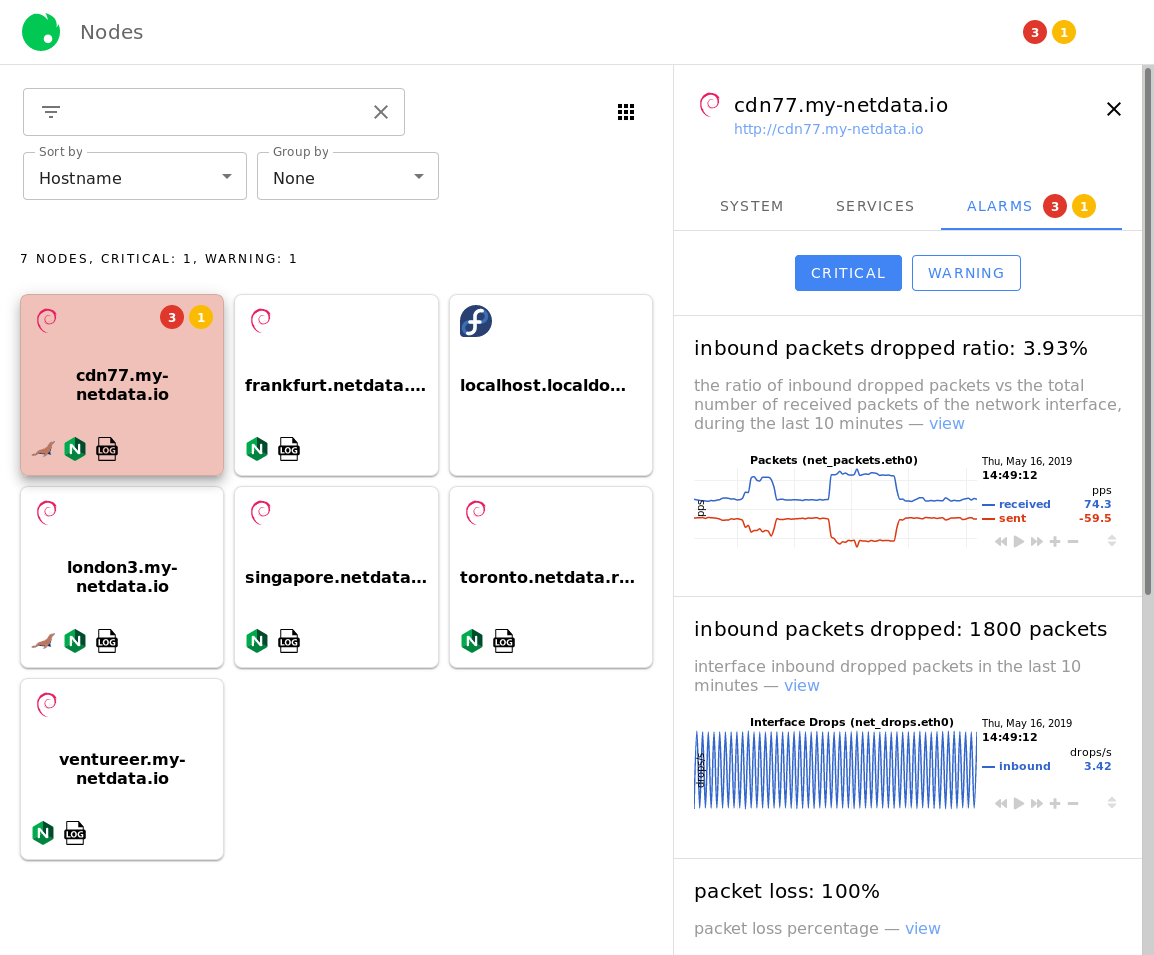 - -### Filtering field - -The search field will be useful for Netdata Cloud users with dozens or hundreds of Nodes. You can filter for the hostname of the Node you're interested in, the operating system it's running, or even for the services installed. - -The filtering field will offer you autocomplete suggestions. For example, the options available after typing `ng` into the filtering field: - -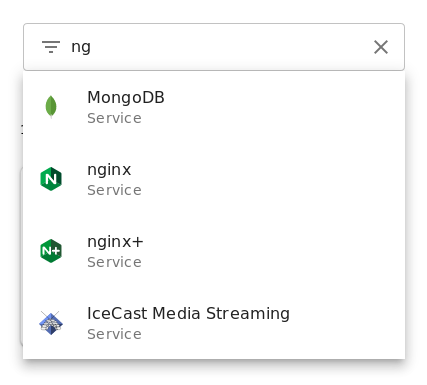 - -If you select multiple filters, results will display according to an `OR` operator. - -### View modes - -To the right of the filtering field is three functions that will help you organize your Visited Nodes according to your preferences. - - - -The view mode button lets you switch between three view modes: - -- **Full** mode, which displays the following information in a large squares for each connected Node: - - Operating system - - Critical/warning alerts in two separate indicators - - Hostname - - Icons for [supported services](#services-available-in-the-nodes-view) - -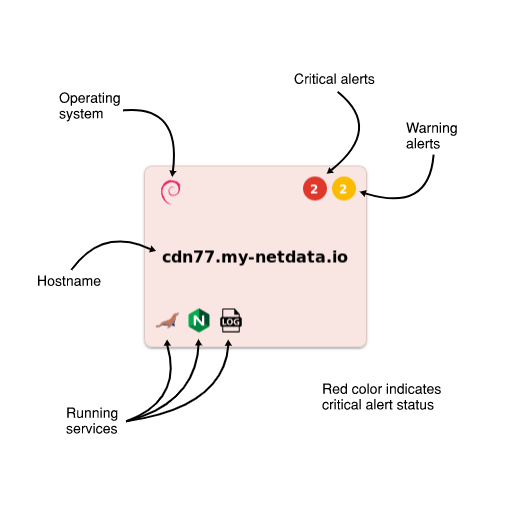 - -- **Compact** mode, which displays the following information in small squares for each connected Node: - - Operating system - -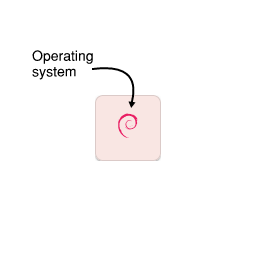 - -- **Detailed** mode, which displays the following information in large horizontal rectangles for each connected Node: - - Operating system - - Critical/warning alerts in two separate indicators - - Hostname - - Icons for [supported services](#services-available-in-the-nodes-view) - -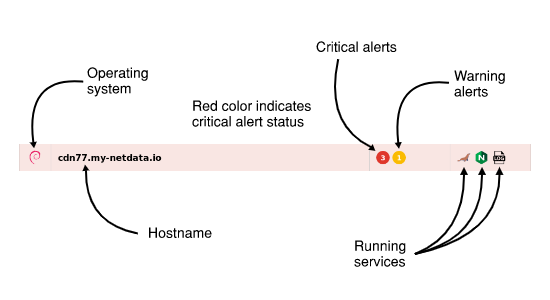 - -## Sorting, and grouping - -The **Sort by** dropdown allows you to choose between sorting _alphabetically by hostname_, most _recently-viewed_ nodes, and most _frequently-view_ nodes. - -The **Group by** dropdown lets you switch between _alarm status_, _running services_, or _online status_. - -For example, the following screenshot represents the Nodes list with the following options: _detailed list_, _frequently visited_, and _alarm status_. - -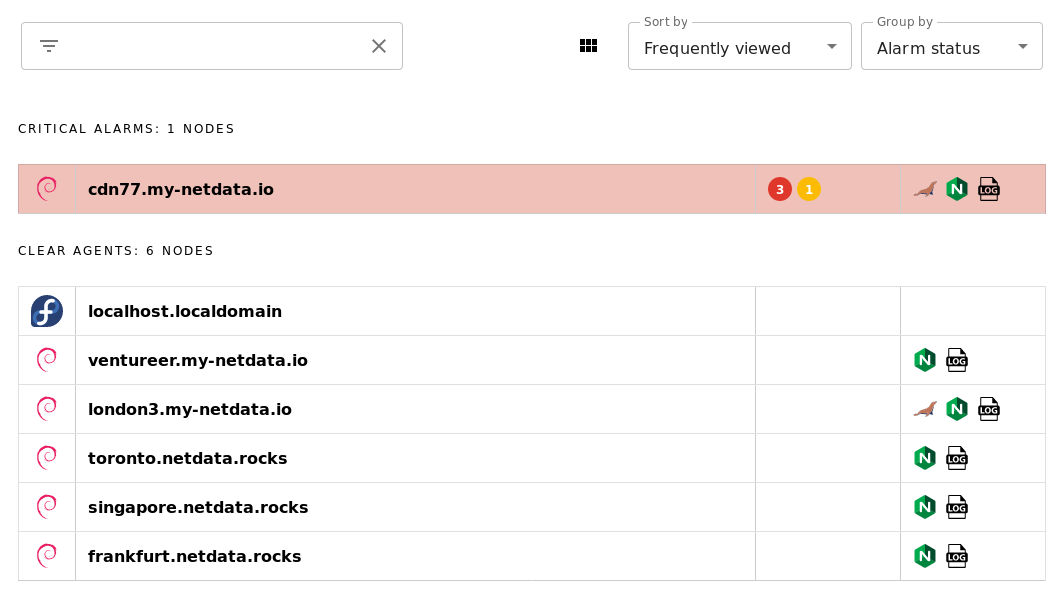 - -Play around with the options until you find a setup that works for you. - -## Adding more agents to the Nodes View - -There is currently only one way to associate additional Netdata nodes with your Netdata Cloud account. You must visit the web dashboard for each node and click the **Sign in** button and complete the [sign in process](signing-in.md#signing-in-to-your-netdata-cloud-account). - -!!! note "" - We are aware that the process of registering each node individually is cumbersome for those who want to implement Netdata Cloud's features across a large infrastructure. - -``` -Please view [this comment on issue #6318](https://github.com/netdata/netdata/issues/6318#issuecomment-504106329) for how we plan on improving the process for adding additional nodes to your Netdata Cloud account. -``` - -## Services available in the Nodes View - -The following tables elaborate on which services will appear in the Nodes View. Alerts from [other collectors](../../collectors/README.md), when entered an alarm status, will show up in the _Alarms_ tab despite not appearing - -### Databases - -These services will appear under the _Databases_ selector beneath the _Services_ tab. - -| Service | Collectors | Context #1 | Context #2 | Context #3 | -|--- |--- |--- |--- |--- | -| MySQL | `python.d.plugin:mysql`, `go.d.plugin:mysql` | `mysql.queries` | `mysql.net` | `mysql.connections` | -| MariaDB | `python.d.plugin:mysql`, `go.d.plugin:mysql` | `mysql.queries` | `mysql.net` | `mysql.connections` | -| Oracle Database | `python.d.plugin:oracledb` | `oracledb.session_count` | `oracledb.physical_disk_read_writes ` | `oracledb.tablespace_usage_in_percent` | -| PostgreSQL | `python.d.plugin:postgres` | `postgres.checkpointer` | `postgres.archive_wal` | `postgres.db_size` | -| MongoDB | `python.d.plugin:mongodb` | `mongodb.active_clients` | `mongodb.read_operations` | `mongodb.write_operations` | -| ElasticSearch | `python.d.plugin:elasticsearch` | `elastic.search_performance_total` | `elastic.index_performance_total` | `elastic.index_segments_memory` | -| CouchDB | `python.d.plugin:couchdb` | `couchdb.activity` | `couchdb.response_codes` | | -| Proxy SQL | `python.d.plugin:proxysql` | `proxysql.questions` | `proxysql.pool_status` | `proxysql.pool_overall_net` | -| Redis | `python.d.plugin:redis` | `redis.operations` | `redis.net` | `redis.connections` | -| MemCached | `python.d.plugin:memcached` | `memcached.cache` | `memcached.net` | `memcached.connections` | -| RethinkDB | `python.d.plugin:rethinkdbs` | `rethinkdb.cluster_queries` | `rethinkdb.cluster_clients_active` | `rethinkdb.cluster_connected_servers` | -| Solr | `go.d.plugin:solr` | `solr.search_requests` | `solr.update_requests` | | - -### Web services - -These services will appear under the _Web_ selector beneath the _Services_ tab. These also include proxies, load balancers (LB), and streaming services. - -| Service | Collectors | Context #1 | Context #2 | Context #3 | -|--- |--- |--- |--- |--- | -| Apache | `python.d.plugin:apache`, `go.d.plugin:apache` | `apache.requests` | `apache.connections` | `apache.net ` | -| nginx | `python.d.plugin:nginx`, `go.d.plugin:nginx` | `nginx.requests` | `nginx.connections` | | -| nginx+ | `python.d.plugin:nginx_plus` | `nginx_plus.requests_total` | `nginx_plus.connections_statistics` | | -| lighthttpd | `python.d.plugin:lighttpd`, `go.d.plugin:lighttpd` | `lighttpd.requests` | `lighttpd.net` | | -| lighthttpd2 | `go.d.plugin:lighttpd2` | `lighttpd2.requests` | `lighttpd2.traffic` | | -| LiteSpeed | `python.d.plugin:litespeed` | `litespeed.requests` | `litespeed.requests_processing` | | -| Tomcat | `python.d.plugin:tomcat` | `tomcat.accesses` | `tomcat.processing_time` | `tomcat.bandwidth` | -| PHP FPM | `python.d.plugin:phpfm` | `phpfpm.performance` | `phpfpm.requests` | `phpfpm.connections` | -| HAproxy | `python.d.plugin:haproxy` | `haproxy_f.scur` | `haproxy_f.bin` | `haproxy_f.bout` | -| Squid | `python.d.plugin:squid` | `squid.clients_requests` | `squid.clients_net` | | -| Traefik | `python.d.plugin:traefik` | `traefik.response_codes` | | | -| Varnish | `python.d.plugin:varnish` | `varnish.session_connection` | `varnish.client_requests` | | -| IPVS | `proc.plugin:/proc/net/ip_vs_stats` | `ipvs.sockets` | `ipvs.packets` | | -| Web Log | `python.d.plugin:web_log`, `go.d.plugin:web_log` | `web_log.response_codes` | `web_log.bandwidth` | | -| IPFS | `python.d.plugin:ipfs` | `ipfs.bandwidth` | `ipfs.peers` | | -| IceCast Media Streaming | `python.d.plugin:icecast` | `icecast.listeners` | | | -| RetroShare | `python.d.plugin:retroshare` | `retroshare.bandwidth` | `retroshare.peers` | | -| HTTP Check | `python.d.plugin:httpcheck`, `go.d.plugin:httpcheck` | `httpcheck.responsetime` | `httpcheck.status` | | -| x509 Check | `go.d.plugin:x509check` | `x509check.time_until_expiration` | | | - -### Messaging - -These services will appear under the _Messaging_ selector beneath the _Services_ tab. - -| Service | Collectors | Context #1 | Context #2 | Context #3 | -| --- | --- | --- | --- | --- | -| RabbitMQ | `python.d.plugin:rabbitmq`, `go.d.plugin:rabbitmq` | `rabbitmq.queued_messages` | `rabbitmq.erlang_run_queue` | -| Beanstalkd | `python.d.plugin:beanstalk` | `beanstalk.total_jobs_rate` | `beanstalk.connections_rate` | `beanstalk.current_tubes` | - -[](<>) diff --git a/docs/netdata-cloud/signing-in.md b/docs/netdata-cloud/signing-in.md deleted file mode 100644 index 03bcd01c..00000000 --- a/docs/netdata-cloud/signing-in.md +++ /dev/null @@ -1,157 +0,0 @@ -# Registration and signing in - -To use the features of [Netdata Cloud](README.md), you must first register an account with Netdata Cloud and associate your first Netdata node with the Netdata Cloud [registry](../../registry/README.md). **Netdata Cloud is entirely free for all Netdata users**, and does not store any metrics created by your machines. You keep your data—Netdata Cloud just connects it all together. - -!!! attention "Opting-in to Netdata Cloud" - By [signing in](signing-in.md) to Netdata Cloud, you opt-in to let Netdata Cloud receive and store the information described [here](../../registry/README.md#what-data-does-the-registry-store). We never store the metrics collected by Netdata agents, just machine GUIDs, person GUID, URLs, and account information. - -## Registering a Netdata Cloud account - -There is only one prerequisite to using Netdata Cloud: A working Netdata agent. If you don't have a running Netdata agent yet, check out the [installation guides](../../packaging/installer/) for more information. - -To begin, visit the web dashboard of your Netdata agent by navigating your browser of choice to `http://SERVER-IP:19999`. You’ll see a dashboard much like this: - -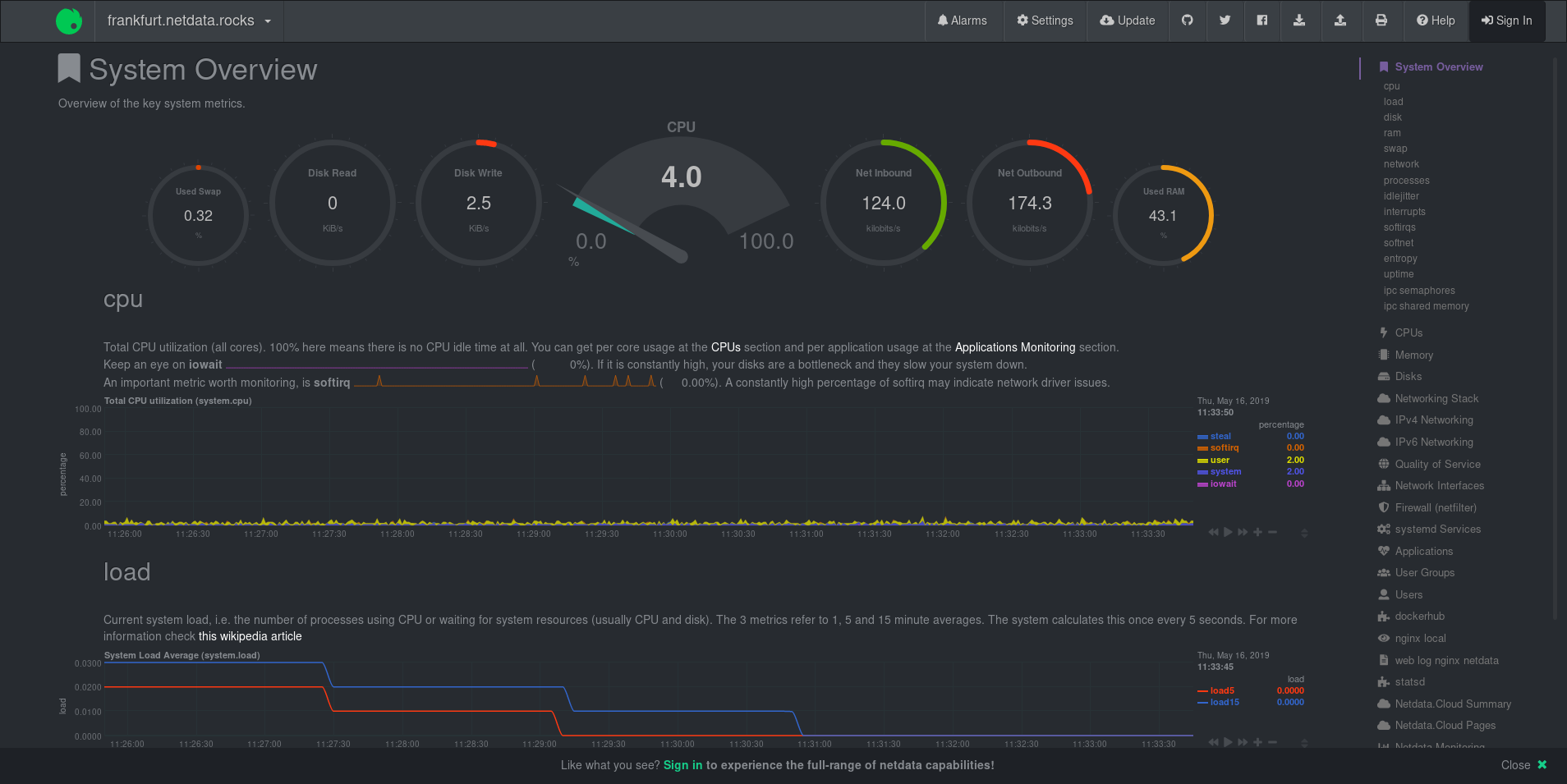 - -From here, you need to register for a Netdata Cloud account. Click on the **Sign in** button on the top-right corner of the dashboard's view. - - - -??? note "Alternative registration routes" - While we recommend the **Sign in** button, the Netdata dashboard has one other direct route registering for or signing in to a Netdata Cloud account. - -``` -The text **Please sign in to netdata.cloud to view your nodes!** contains a link to access Netdata Cloud. - -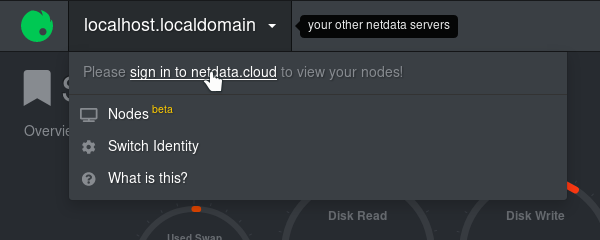 - -Two other routes exist, but they are more directly related to accessing the Nodes View. They will, however, require either registration or sign in and thus are valid routes to access Netdata Cloud. - -One route can be found in the **Nodes Beta** button the left side of the navigation menu: - - - -A second route can be found in the Nodes List—the drop-down menu in the top-left corner of the Netdata dashboard: - - 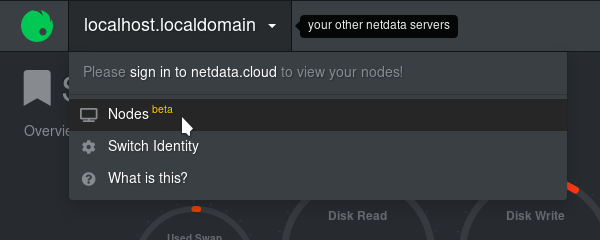 -``` - -??? note "Registration route when using a private registry" - If you're using a private registry, clicking the **Sign in** button will display a modal window warning you about the process of migrating away from your private registry and to Netdata Cloud's registry. - -``` -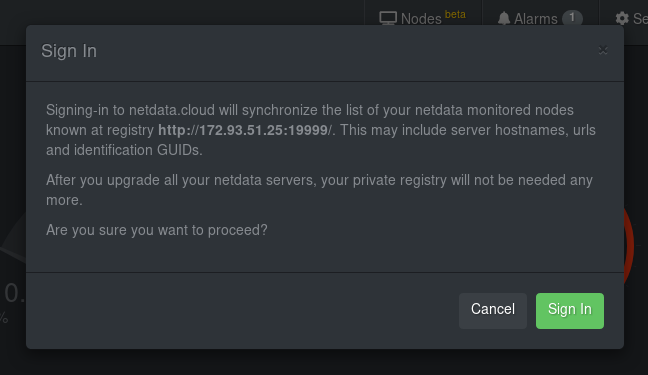 - -If you agree to use Netdata Cloud over your private registry, and opt-in to let Netdata Cloud receive and store the information described [here](../../registry/README.md#what-data-does-the-registry-store), you should click the **Sign in** button again. If not, click the **Cancel** button to continue using your private registry. -``` - -### Choosing your registration or sign in method - -After clicking the **Sign in** button, you'll be directed to the Netdata Cloud registration/sign in page. Choose to authorize with your Google account, GitHub account, or email. - -!!! attention - Be consistent with the sign in method you use, whether GitHub, Google, or email. If you sign in via different methods, the system will create multiple Netdata Cloud accounts, one for each sign-in method used. We plan to offer multiple authentication methods for the same account in the future. - -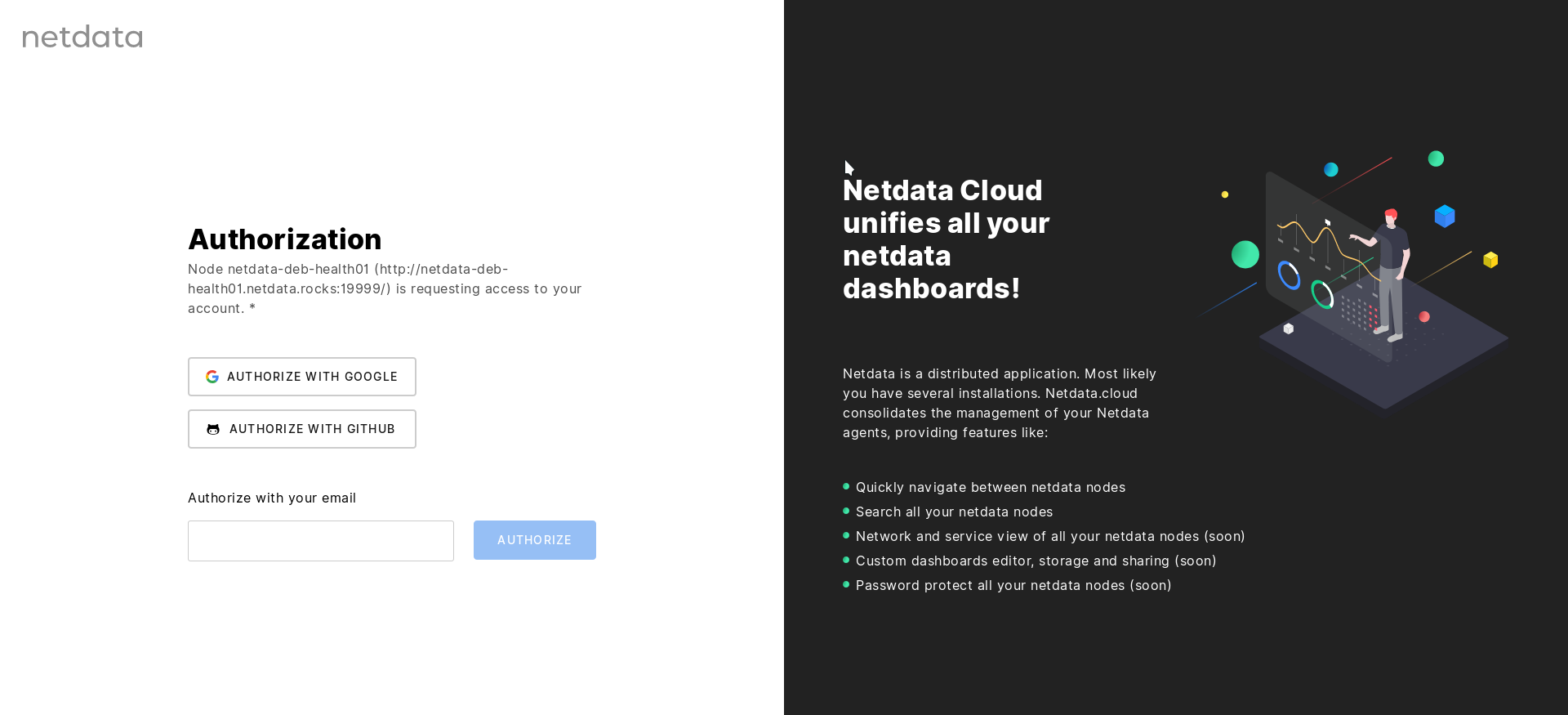 - -### Registration via Google - -Click the **Authorize with Google** button to begin registration. You will be redirected to a Google authentication form where you confirm you will "share your name, email address, language preference, and profile picture with netdata.cloud." - -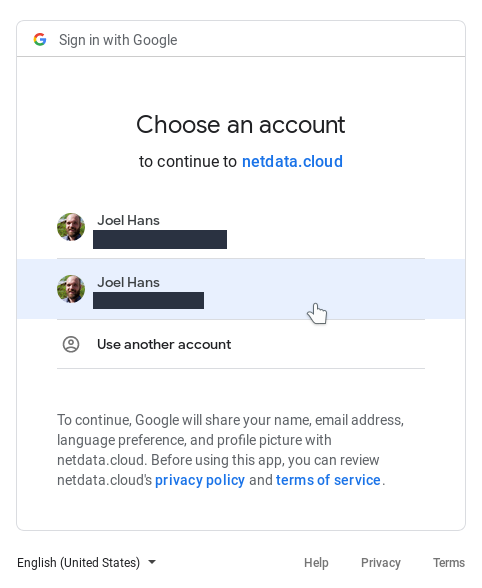 - -Click on the account you would like to connect to Netdata Cloud to continue and then skip down to [Visiting Netdata Cloud for the first time](#visiting-the-nodes-view-for-the-first-time) for further instructions. - -### Registration via GitHub - -Click the **Authorize with GitHub** button to begin registration. You will be redirected to a GitHub authentication form where you confirm to share your email address with Netdata Cloud to create your account. - -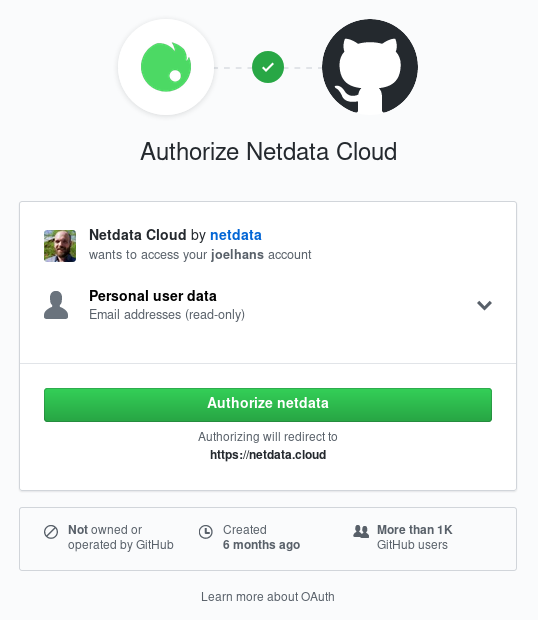 - -Click the **Authorize Netdata** button to continue and then skip down to [Visiting Netdata Cloud for the first time](#visiting-the-nodes-view-for-the-first-time) for further instructions. - -### Registration via email - -Enter your preferred email into the field and click the **Authorize** button. - -Open your email account and check for the verification email—it should arrive in less than a minute. If it doesn't show up, check your spam folder or click the **Resend email** button in the Netdata Cloud interface. - -When the email arrives, open it and click on the green **Sign in** button and then skip down to [Visiting Netdata Cloud for the first time](#visiting-the-nodes-view-for-the-first-time) for further instructions. - -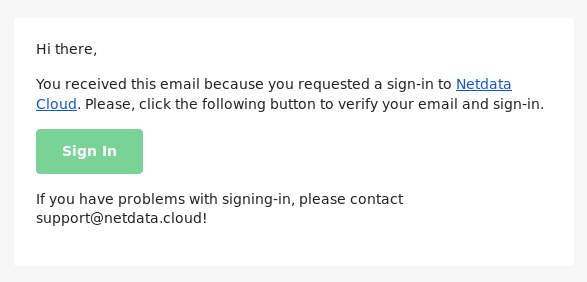 - -## Visiting the Nodes View for the first time - -Regardless of which sign in method you used, you'll now be redirected back to your Netdata agent's dashboard. This node has now been associated with your Netdata Cloud account. Netdata Cloud uses a list of nodes associated with your account to populate the Nodes List dropdown in the dashboard and the Nodes View feature of Netdata Cloud. - -**For more information on how to use the Nodes View, visit the [Nodes View guide](nodes-view.md).** - -## Signing in to your Netdata Cloud account - -The process of signing in to an existing Netdata Cloud account the same as [registering for a new account](#registering-a-netdata-cloud-account). The recommended method is to use the **Sign in** button at the top-right corner of a Netdata nodes's dashboard. Choose the method you used to register for your Netdata Cloud account and complete the process. - - - -## Adding additional nodes to your Netdata Cloud account - -There is currently only one way to associate additional Netdata nodes with your Netdata Cloud account: You must visit the web dashboard for each node and click the **Sign in** button and complete the [sign in process](#signing-in-to-your-netdata-cloud-account). - -!!! note "" - We are aware that the process of registering each node individually is cumbersome for those who want to implement Netdata Cloud's features across a large infrastructure. - -``` -Please view [this comment on issue #6318](https://github.com/netdata/netdata/issues/6318#issuecomment-504106329) for how we plan on improving the process for adding additional nodes to your Netdata Cloud account. -``` - -## Private registries and Netdata Cloud - -If you use a [private registry](../../registry/README.md#run-your-own-registry), and sign in to Netdata Cloud, you'll be using the Netdata Cloud registry in addition to your private registry. - -Clicking the **Sign in** button on the Netdata dashboard will display a modal window warning you about the synchronization of your private registry's entries to the Netdata Cloud's registry. - -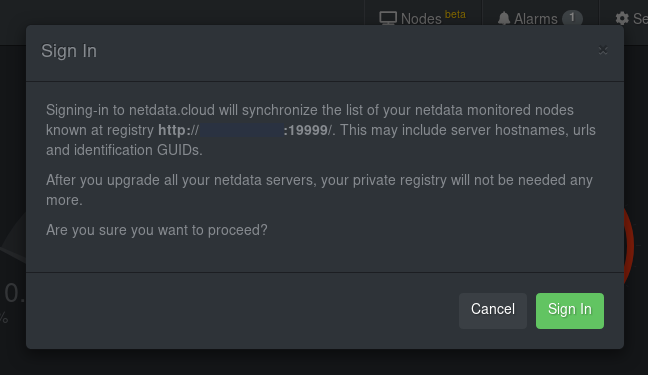 - -If your company's data policies don't allow storing information about your nodes on the Netdata Cloud registry, you should click the **Cancel** button and continue using your private registry. You'll be able to access the Nodes List in the top-left corner of a Netdata dashboard, but you won't be able to use the [Nodes View](nodes-view.md) feature within Netdata Cloud, or any of the [additional features](https://blog.netdata.cloud/posts/netdata-cloud-announcement/#what-features-will-netdata-cloud-offer) on our roadmap. You can also sign up for the waiting list for the [hosted and/or on-premises versions of Netdata Cloud](README.md#running-netdata-cloud-on-premises-or-as-a-hosted-instance) that we're working on. - -If you agree to use Netdata Cloud over your private registry, and opt-in to let Netdata Cloud receive and store the information described [here](../../registry/README.md#what-data-does-the-registry-store), you should click the **Sign in** button again to continue the registration/sign in process. - -### Returning to your private registry - -If you register for or sign in to Netdata Cloud from a node previously associated with a private registry, you can easily return to your private registry by signing out. - -You can sign out in two ways: - -1. **From a node's dashboard**: In the top-right corner you will find a dropdown menu with your email address. Click that and then click the **Sign Out** button. -2. **From Netdata Cloud**: Click on your profile picture in the top-right corner and then click on the **Sign Out** button. - -Signing out from Netdata Cloud and returning to your private registry *does not remove* the [information stored](../../registry/README.md#what-data-does-the-registry-store) about your nodes or account details. - -But, upon signout, your Nodes List on all dashboards will once more be populated by your private registry and not Netdata Cloud. - -<!-- ## The 'Synchronize with Netdata Cloud' button - -Once signed in to Netdata Cloud, the Nodes List dropdown will now show a button labeled `Synchronize with netdata.cloud`. - -The `Synchronize with Netdata Cloud` button is a migration (or import) tool for Netdata Cloud. If either the public or your private registry contains a list of nodes associated with your `person_guid`, it will import them into Netdata Cloud and associate them with the `accounts` information in the Netdata Cloud registry. - -When you click the `Synchronize with netdata.cloud` button, you will receive one of two popup messages based on whether you were using the public registry (at `registry.my-netdata.io`) or a private registry. - -**Public registry**: - -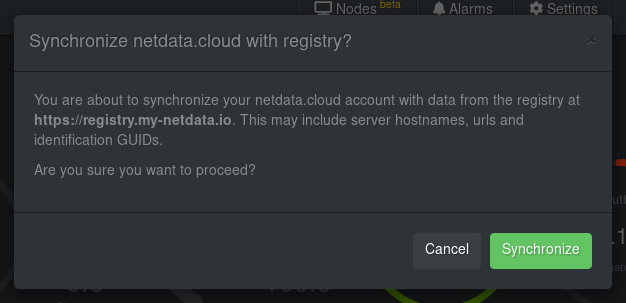 - -**Private registry**: - -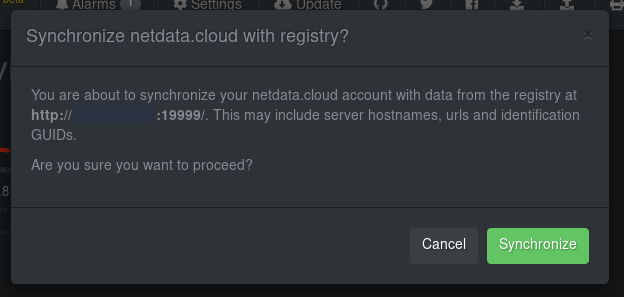 - -If you do not want to synchronize your registry of choice with Netdata Cloud, click `Cancel`. - -If you do, click `Synchronize`. This will push GUIDs, hostnames, and URLs to Netdata Cloud's registry. - -Now, when you visit the Nodes View, you will be able to see all the nodes that were once associated with the public/private registry you were using previously. --> - -## What's next? - -Learn how to use the [Nodes View](nodes-view.md) to monitor many nodes concurrently. - -[](<>) |
